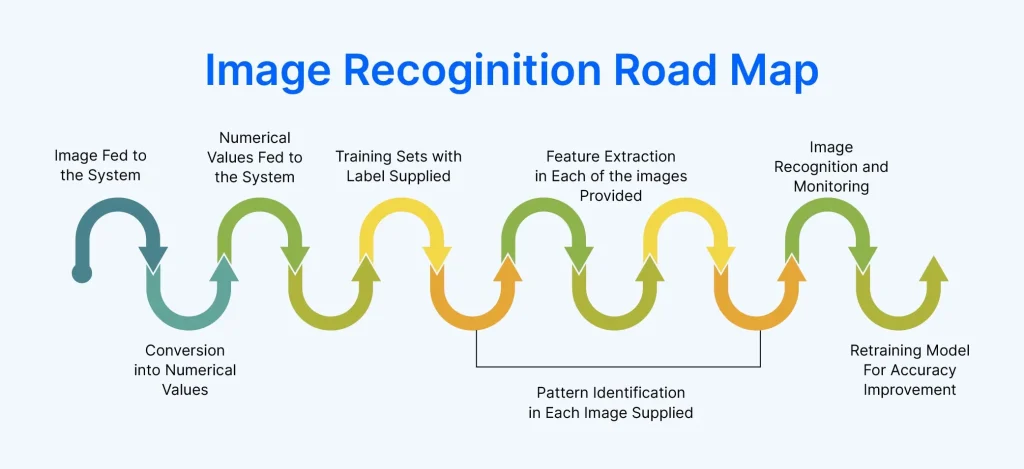Introduction
AI-based image recognition is a technique that recognizes objects, faces of people, written text, and other information from photos. When AI is allowed to read and learn from a large number of photos, recognition accuracy increases. Pattern recognition, which encompasses image recognition as well, is the general technique that identifies objects with specific meanings from a variety of data sources, including voice and image.
AI image recognition makes use of machine learning technology, in which vast volumes of picture data are read and processed by the AI to learn from, and from which it continuously stores image data to enhance its accuracy in image recognition.
Artificial Intelligence (AI) has revolutionized the way we interact with technology, and one of its remarkable applications is image recognition. This cutting-edge capability, powered by machine learning algorithms, has transformed various industries, from healthcare to retail. In this blog, we’ll delve into the workings of AI image deduction, exploring its mechanisms and diverse applications.
What is AI Image Recognition?
AI image recognition is a subset of computer vision, a field where machines are trained to interpret and make decisions based on visual data. The process involves feeding large datasets of images into machine learning models, enabling them to learn patterns, features, and distinctions. As the model learns, it becomes capable of recognizing and categorizing objects or patterns within images. AI recognition capabilities are reshaping industries, offering unparalleled accuracy in identifying patterns, objects, and complex data, ushering in a new era of intelligent automation.
How Image Recognition Evolved Over Time?
The evolution of humans takes over 500 million years to attain this state of perfection. We’ve come a long way in recent years to give computers and other technologies the ability to see.

The late 1950s saw the beginnings of what would eventually become image recognition technology. Despite having no direct connection to the mathematical side of evolution, a seminal 1959 study is frequently cited as the foundation for understanding the fundamentals of picture recognition.
The study detailed the basic response characteristics of visual neurons, noting that the processing of basic structures—like an object’s immediately recognizable edge—is the first step in the image identification process. The following deep learning algorithms employed in computer-based picture recognition still have their roots in this idea. The first digital photo scanner was created about the same period, which is another landmark.
Since his PhD thesis “Machine perception of three-dimensional solids“ in 1963, Lawrence Roberts has been recognized as the true founder of image recognition or computer vision applications.
How Does Image Recognition Work?
Image recognition employs artificial intelligence to enable machines to identify and categorize objects within images. Initially, a model is trained on labeled datasets, learning patterns and features associated with specific objects. The training involves adjusting the model’s parameters until it can accurately recognize objects. During application, the model analyzes new images, extracting features and comparing them to the learned patterns. Advanced techniques, including convolutional neural networks (CNNs), are commonly used for image recognition. This technology finds widespread use in fields such as facial recognition, medical imaging, and autonomous systems, revolutionizing how machines interpret visual information.
Using Traditional Computer Vision
The process of picture filtering, image segmentation, feature extraction, and rule-based classification is known as the computer vision pipeline and is the standard method used in image recognition. However creating such pipelines involves a great deal of development effort, testing, and manual parameter tweaking, as well as extensive knowledge of image processing and computer vision.
Scalability and the capacity to apply computer vision and pixel-based image recognition systems to different contexts and settings are generally severely restricted in older systems.
Using Machine Learning and Deep Learning
Contrarily, machine learning for image identification uses algorithms to extract hidden information from a dataset of both good and poor samples (see supervised vs. unsupervised learning). Deep learning, which uses numerous hidden layers of a neural network in a model, is the most widely used machine learning technique. AI for image processing revolutionizes data analysis by employing advanced algorithms, enabling swift and precise recognition, interpretation, and enhancement of visual content.
When compared to historical algorithms, the most potent and effective algorithm either uses hardware that is several times less expensive or produces performance that is many times better on hardware that is equal. Performance of computer vision algorithms has increased significantly over time:
With an inference time of 330 ms per frame, the Mask RCNN algorithm was the fastest real-time object detector on the MS COCO benchmark in 2017.
On the same test, the YOLOR algorithm, which was launched in 2021, outperforms the well-liked YOLOv4 and YOLOv3 deep learning algorithms, achieving inference speeds of 12 ms.
And in July 2022, the speed and accuracy of the YOLOv7 algorithm even greatly outperformed that of YOLOR. A recently released model called YOLOv8 reached state-of-the-art performance for real-time object detection in 2023.
As opposed to the conventional computer vision method used in the early stages of image processing two decades ago, deep learning just needs an understanding of the engineering behind a machine learning tool—not specialized knowledge in certain areas of machine vision—to produce hand-crafted features. More recent deep-learning techniques only require tens of learning samples, whereas earlier techniques required massive amounts of training data.
Typical Inference Models for AI-based Image Recognition
In the era of image recognition, models are designed to detect people, objects, and vehicles within visual data. Leveraging convolutional neural networks (CNNs) and object detection algorithms, these models analyze images to identify and delineate individuals, various objects, and different types of vehicles. Such applications find use in security systems, traffic monitoring, and retail analytics, offering valuable insights for diverse industries.
Detecting People, Objects, and Vehicles
AI-based image recognition models, often powered by pose estimation algorithms, excel in detecting human skeletal structure and posture. By analyzing joint positions and angles in images or videos, these models can infer body movements and postures accurately. This capability is crucial in applications ranging from fitness tracking and gesture recognition to biomechanics research, contributing to advancements in healthcare, sports science, and interactive technologies.
This inference model recognizes objects, people, and cars in pictures. People detection looks for traffic jams on public roads and in open areas, as well as worker activity on building sites. On highways, traffic congestion is monitored via vehicle detecting systems. AI image detection is at the forefront of technological advancements, allowing systems to swiftly and accurately identify objects and patterns within images, enhancing automation and decision-making processes.
Facial Recognition in AI-based Image Recognition
Facial recognition models utilize deep learning techniques to analyze facial features and patterns, enabling accurate identification and authentication. Widely applied in security systems, mobile devices, and social media, these models provide personalized experiences, secure access control, and streamlined identity verification. However, ethical considerations and privacy concerns necessitate careful implementation and adherence to guidelines.
To verify an individual’s identity, this technology analyzes features such as the eyes, nose, mouth, and other features from 2D or 3D image data and compares them to a database of previously recorded face data. Some items can detect people even while they are wearing masks, while others are capable of measuring temperature since the COVID-19 pandemic.
Identifying Diseased Images from Medical Images (CT or MRI)
AI plays a pivotal role in healthcare through image recognition models designed to identify diseased patterns in medical images, such as CT scans or MRIs. These models, often based on deep learning architectures, can detect anomalies, tumors, or specific medical conditions, aiding in early diagnosis and treatment planning. This technology enhances the efficiency of radiologists and contributes to improved patient outcomes, marking a significant advancement in medical imaging and diagnostics. Ethical considerations regarding data privacy and model interpretability are critical in the deployment of these applications within the healthcare sector. AI image analysis empowers industries to extract valuable insights from visual data, facilitating informed decision-making and unlocking new dimensions of efficiency and understanding.
This method uses medical scans (CT or MRI) to identify sick regions, including cerebral aneurysms. The ability to gather high-resolution CT and MRI data has emerged in recent years. The ability of AI to learn from vast amounts of high-resolution image data that has been saved has also significantly increased the technology’s ability to diagnose diseases.
Different Fields of Application for Image Recognition with ML
Image recognition powered by machine learning has transcended its early applications, becoming a transformative technology across diverse fields. Its versatility and precision make it a powerful tool, influencing everything from healthcare to retail and beyond.
Healthcare
In the realm of healthcare, image recognition models are revolutionizing diagnostics. From identifying abnormalities in medical imaging like X-rays, CT scans, and MRIs to assisting in the detection of diseases and monitoring treatment responses, machine learning-based image recognition is enhancing the accuracy and efficiency of medical professionals.
Retail
Retailers leverage image recognition to optimize various processes. This includes inventory management through automated stock tracking, as well as enhancing the customer shopping experience with technologies like visual search and virtual try-on. Image recognition models facilitate personalized product recommendations based on customer preferences.
Agriculture
In agriculture, image recognition aids in crop monitoring and management. Drones equipped with cameras capture images of fields, and machine learning models analyze these visuals to identify crop health, detect diseases, and optimize irrigation strategies. This application enables precision farming and resource optimization.
Automotive
The automotive industry employs image recognition for advanced driver assistance systems (ADAS). Cameras integrated into vehicles detect objects, pedestrians, and lane markings, contributing to features like collision avoidance, lane-keeping assistance, and adaptive cruise control. Image recognition is also fundamental in the development of autonomous vehicles.
Security and Surveillance
Security systems extensively use image recognition for facial recognition, object detection, and anomaly identification. This technology enhances surveillance capabilities, streamlining security processes, and providing real-time alerts in critical scenarios.
Environmental Monitoring
Image recognition assists in environmental monitoring by analyzing satellite and drone imagery. This application helps track deforestation, monitor wildlife populations, and assess changes in landscapes, contributing to environmental conservation efforts.
Manufacturing
In manufacturing, image recognition is employed for quality control and defect detection. Machine learning models analyze images of manufactured products to identify defects, ensuring adherence to quality standards and minimizing production errors.
Why IntellicoWorks is Best Choice for Your Business Innovation
IntellicoWorks stand as a beacon of innovation, offering tailored strategies that propel your business toward unprecedented success. What sets IntellicoWorks apart is our commitment to excellence, driven by a team of seasoned professionals with deep expertise in emerging technologies. Our collaborative approach ensures a comprehensive understanding of your unique challenges, paving the way for innovative solutions that align seamlessly with your goals. From cutting-edge AI implementations to robust data analytics, IntellicoWorks empowers your business to stay at the forefront of innovation. We don’t just offer services; we forge strategic partnerships, guiding you through a journey of growth, adaptability, and sustained excellence. Choose IntellicoWorks, where innovation meets impact, and witness the transformative potential that drives businesses to new heights.
Wrap UP
This exploration of picture identification and how it works best with machine learning has opened our eyes to a world of creativity and comprehension. We have examined the core of recognition technology, including everything from the complexities of both human and machine picture interpretation to fundamental procedures like training to the different potent algorithms. AI Development Services empower businesses to connect the full potential of artificial intelligence, driving innovation, efficiency, and transformative solutions for a digitally evolved future.
Are You Planning to Execute an AI Project?
Follow IntellicoWorks for more insights!


